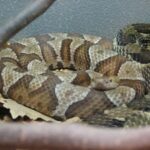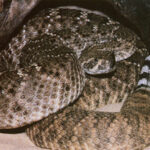Missouri has 44 species and subspecies of snakes, and of these 85% fall into the “harmless” category. That is to say, they are not venomous. In fact, Missouri only has five species of venomous snakes, all of which belong to the family of snakes known as “pit vipers” due to the heat-sensitive pits above their nostrils. Not all of these snakes can be found in all areas of the state, but all of Missouri’s venomous snakes are an important (some might say essential) part of the ecosystem. Here’s what you need to know when it comes to identifying and understanding Missouri’s venomous snake population.
Western Cottonmouth
The western cottonmouth (also referred to as a “water moccasin”) is perhaps the most feared of all of Missouri’s venomous snakes. Not only do western cottonmouths have a reputation for being short-tempered, they have a potent venom. You should always use care in areas where western cottonmouths are known to live, and seek medical attention if bitten. The bite of the western cottonmouth accounts for about %6.6 of all snakebite-related fatalities in the United States.
Western cottonmouths in Missouri can be found in two distinct environments: the swamps of the Mississippi Lowlands area (the “bootheel”) and the streams and rivers of the Ozarks.
So, how can you identify a western cottonmouth? Look for snakes that are heavy-bodied and dark. They have crossbands, but these are usually not distinguishable on adults (juveniles tend to have more distinct bands, and a yellow tail-tip). When disturbed in areas with plenty of cover, most western cottonmouths will flee. In areas where the snake feels vulnerable, however, they will stand their ground and display the the white lining of their mouths, from which they derive their name. If encountered, be sure to give this venomous snake plenty of room.
Keep in mind that not every water snake is a western cottonmouth. In fact, most water snakes encountered in Missouri are harmless. These harmless snakes are often mistaken for Missouri’s most feared venomous snake and needlessly killed.
Osage Copperhead
The Osage copperhead is well-known (and widely feared) as one of Missouri’s venomous snakes. However, there has never been a recorded fatality in Missouri that resulted from the bite of this misunderstood snake. Osage copperheads, like nearly all snakes, are secretive and prefer to be left alone. Most snakebites occur when people have attempted to handle or otherwise harass these snakes.
Osage copperheads can be found throughout Missouri, except for the extreme northern border. They prefer rocky woods, but may be found in a variety of habitats.
These venomous snakes can be identified by their distinctive coloring, which can range from a bright copper, to pinkish brown, to almost gray. Osage copperheads can be distinguished from similarly colored (harmless) snakes by the presence of their hourglass-shaped bands, which are normally a dark brown. These bands are clearly hourglass-shaped: narrower at the snake’s back and wider towards the animal’s stomach. Juvenile copperheads share the coloring of the adults, but have a distinctive greenish-yellow tail.
Timber Rattlesnake
Often Missouri residents are surprised to find rattlesnakes among our venomous snake species. In fact, there are three different rattlesnake species that inhabit the state. The largest of them (and Missouri’s largest venomous snake in general) is the timber rattlesnake, which can be found throughout Missouri (except in a few counties, where they have been eliminated).
Few people encounter timber rattlesnakes in Missouri, and even fewer are bitten. Timber rattlesnakes tend to live in remote rocky areas, and are quite shy when encountered, preferring to remain motionless or escape without notice.
These venomous snakes can be identified by their relative size, their thick bodies, and a rust-colored stripe that runs down their back, from neck to tail. They generally have black or brown markings, though this varies from snake to snake, and all have a large rattle at the end of their tails.
Eastern Massasauga Rattlesnake
The eastern massasauga rattlesnake is not often seen in Missouri, dwelling in just a few counties north of the Missouri River in moist prairies and marshes. This venomous snake is considered to be state endangered in Missouri.
Eastern massasaugua rattlesnakes are not as large as the timber rattlesnake, and aren’t as heavy-bodied. These snakes can be distinguished by their dark ground color (normally gray) and the black blotches that line their backs. As with all rattlesnakes, they also have a prominent rattle at the end of their tails.
Western Pygmy Rattlesnake
As the name suggests, the western pygmy rattlesnake is the smallest of Missouri’s rattlesnakes, and is one of the smallest rattlesnakes in the U.S. These rattlesnakes are found in the southern Ozarks of Missouri, along the Arkansas border. They prefer rocky, open area, such as glades.
Pygmy rattlesnakes can be identified by their small size, their tiny rattle, and their unique coloration. These snakes typically have a solid gray or brown ground color, with small dark blotches along their backs. An orange-brown stripe typically runs down their back from head to tail.
There are no known human deaths reported from this venomous snake species.







